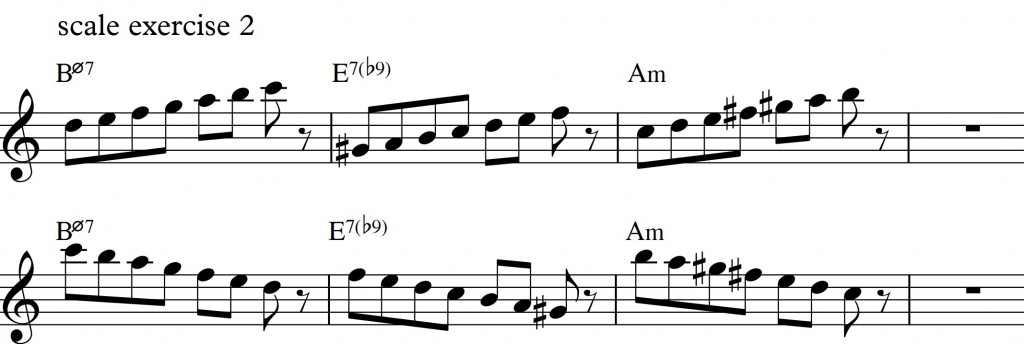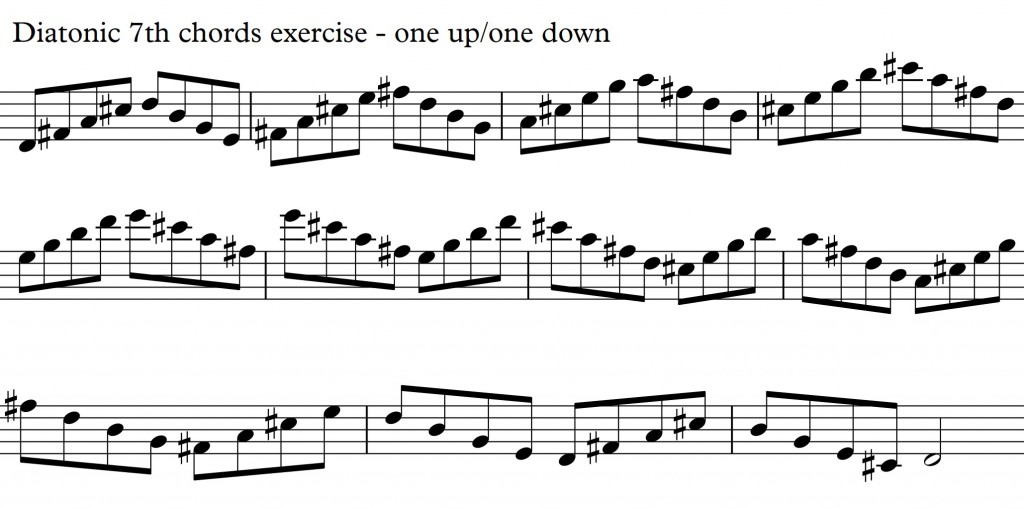This video lesson explains the basic scales and chords used over a minor II-V-I – Am.
The minor II-V-I consists of three different scales, one on each chord of the II, the V and the I.
In this video i work on the Am6 II-V-I, Bø7, E7(b9) and Am6.

On the Bø7 chord the II of the II-V-I I play the Cmajor scale from the 7th degree, B C D E F G A B C,
on the E7(b9) i play A-harmonic minor from the Eof, E F G# A B C D E F,
and on the Dm6 i play D-melodic minor, D E F G A B C# D E.
These scales are maybe the most diatonic scales to the these functions.

I made a set of exercises which you can practise to get the scales well into your fingers but also into you ears.
the first exercise basically just plays the scale up from each chord over a four bar period.
I repeat the exercise, more times.
Second line of the exercise is playing the same material but descending.

The next exercise takes the scales from the third degree of each scale and again just plays the scale up.
Second line is playing the scale down.

The arpeggios, the chord tones or the target notes which I sometimes calls the chord tones is the next matter.
on the Bø7(9) you have notes B D F A C, on the E7(b9) you have the E G# B D F and on the Am6 you have the A C E G# B.
I play the arpeggios till the 9th degree of the chord, because i like the sound of the 9th but also because its one of the most common extensions of the chords.

You can make up any exercise you want, i made the following exercise, playing the arpeggios up and down:


Try to find exercises that suits you.
I also like to play quarternote lines staying within the chordtones.
Here is an example of how this sounds:

I use only chordtones and the rhythm is quarter notes, so in this case, four notes in the bar.
the tones are: high A B D F on Bø7, E G# B D on the E7(b9), C A C E – G# A C E on the two Am chords,
next system is: B A B D, E B G# D, C A G# A, C G# A.
With this method you get the notes in your fingers and into your ear in a slow and controlled way.
The second quarter note, chord tone exercise:

The notes are: starting on high D B F D, B G# E D, C A G# E, C A G# B.
The lower system: A B D F, E D E B, C E G# E, C B A.
I will now play some examples of II-V-I lines. I only use the material I presented in this video in the examples.
I start on the 7th of the Bø7 going down making an approach through the E and G to the F going down the scale of Bø7. Hitting the B of the E7(b9) i continue down the scale to the G# running up the arpeggio of E7(b9) to the high F semi approaching the C of the Am6 with a E and D from above. On the C of the Am6 i jump down to play the E triad up one octave to the E, running down the scale to end on the B.
running up the complete arpeggio of Bø7 to the high C and from there going down the scale approaching the F of the E7(b9) through the g and E. From the F i go donw the scale to the G# going up the scale hitting a C on the Am major 9 chord going up the arpeggio to end on a high E making a glissando to the B.
i start with an approach to the F, via the E and G, going down the scale to the G# of the E7(b9) jumping up to the high F going down the scale to the C jumping again up to a high G# playing up to the high C to play th Caug triad down, followed by the E triad followed by a small tail E B C D.
Thank you for watching.
More videos, licks and tricks here




























